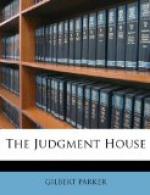“Poor Ruddy! Poor Ruddy!” she said.
Once again before she entered the sitting-room, as she turned and looked back, she said:
“Poor boy . . . Yet he knew about a thousand years ago!” she added with a nervous little laugh, and with an air of sprightly eagerness she entered to Ian Stafford.
CHAPTER X
AN ARROW FINDS A BREAST
As he entered the new sphere of Jasmine’s influence, charm, and existence, Ian Stafford’s mind became flooded by new impressions. He was not easily moved by vastness or splendour. His ducal grandfather’s houses were palaces, the estates were a fair slice of two counties, and many of his relatives had sumptuous homes stored with priceless legacies of art. He had approached the great house which Byng had built for himself with some trepidation; for though Byng came of people whose names counted for a good deal in the north of England, still, in newly acquired fortunes made suddenly in new lands there was something that coarsened taste—an unmodulated, if not a garish, elegance which “hit you in the eye,” as he had put it to himself. He asked himself why Byng had not been content to buy one of the great mansions which could always be had in London for a price, where time had softened all the outlines, had given that subdued harmony in architecture which only belongs to age. Byng could not buy with any money those wonderful Adam’s mantels, over-mantels and ceilings which had a glory quite their own. There must, therefore, be an air of newness in the new mansion, which was too much in keeping with the new money, the gold as yet not worn smooth by handling, the staring, brand-new sovereigns looking like impostors.
As he came upon the great house, however, in the soft light of evening, he was conscious of no violence done to his artistic sense. It was a big building, severely simple in design, yet with the rich grace, spacious solidity, and decorative relief of an Italian palace: compact, generous, traditionally genuine and wonderfully proportionate.
“Egad, Byng, you had a good architect—and good sense!” he said to himself. “It’s the real thing; and he did it before Jasmine came on the scene too.”
The outside of the house was Byng’s, but the inside would, in the essentials, of course, be hers; and he would see what he would see.
When the door opened, it came to him instantly that the inside and outside were in harmony. How complete was that harmony remained to be seen, but an apparently unstudied and delightful reticence was noticeable at once. The newness had been rubbed off the gold somehow, and the old furniture—Italian, Spanish—which relieved the spaciousness of the entrance gave an air of Time and Time’s eloquence to this three-year-old product of modern architectural skill.
As he passed on, he had more than a glimpse of the ball-room, which maintained the dignity and the refined beauty of the staircase and the hallways; and only in the insistent audacity and intemperate colouring of some Rubens pictures did he find anything of that inherent tendency to exaggeration and Oriental magnificence behind the really delicate artistic faculties possessed by Jasmine.




